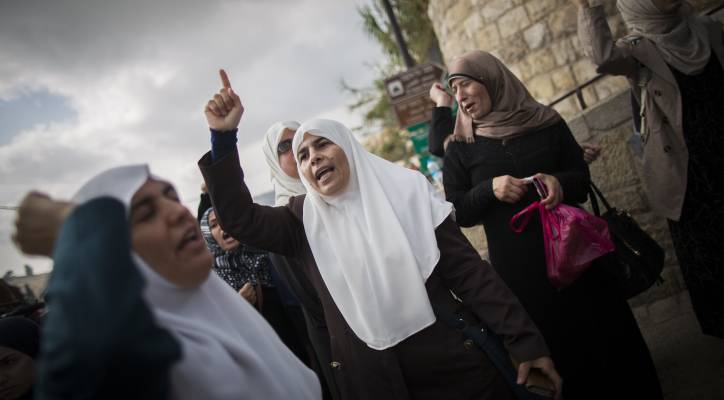A recent New York Times article highlights the issue of biased reporting on the Temple Mount.
There are pluses and minuses to a recent New York Times article, “Muslim Women Join Feud Over a Holy Site” by Diaa Hadid, about Palestinian harassment of Jews visiting the Temple Mount. Let’s start with the pluses, since we don’t often have the occasion to use that word when discussing Times coverage of Israel.
The first plus is that the story was covered at all by a newspaper that tends to shy away from exploring the uglier sides of Palestinian society and reserve hard-hitting reporting for Israel.
It is certainly newsworthy that visibly Jewish groups are met by shrieking, shouting, chanting and hostile gestures, all aimed at making the Temple Mount, the holiest site in Judaism, a Jew-free zone. And it is refreshing that the newspaper, which CAMERA has frequently criticized for ignoring or downplaying Palestinian incitement and hate speech aimed at Jews, is letting readers know about important, if uncomfortable, activities at an epicenter of the Arab-Israeli conflict.
The second plus is that a problematic passage in the piece was amended after CAMERA brought the issue to the attention of the newspaper.
The piece as originally published downplayed the importance of the Temple Mount to Jews relative to its importance to Muslims, which is, if nothing else, unhelpful to readers seeking to understand tensions on the Mount. Although an early paragraph did note in passing that the area “is held sacred by both” Jews and Muslims, a more focused follow-up later in the piece stated only that the compound is “revered by Muslims,” while failing to note that it is revered by Jews:
The 37-acre compound in Jerusalem’s walled Old City is revered by Muslims, who believe that the Prophet Muhammad’s mystical journey took him from Mecca to Al Aqsa, and from there to the heavens. And it is for Jews the site of the First and Second Temples.
It is inexplicable that Muslim “reverence” would be juxtaposed with no-such Jewish feelings. To the newspaper’s credit, it modified the language before the piece went to print, so that the more balanced final version stated:
The 37-acre compound in Jerusalem’s walled Old City is the holiest site in Judaism and the third holiest place in Islam. Muslims believe that the Prophet Muhammad’s mystical journey took him from Mecca to Al Aqsa, and from there to the heavens. And it is for Jews the site of the First and Second Temples.
Unfortunately, although the newspaper took these positive steps related to its reluctance to cover Palestinian misbehavior and to the slanted language it tends to use when reporting on Israelis and Palestinians, the article also made clear there’s still ground to cover in both regards.
One minus: Editors declined to amend language that suggested Jews, the party said to be responsible for “increasing tensions,” are thus responsible for the Palestinian harassment they face:
A small group of religious Jews have for years sought to pray at the site, and more Jews have visited in the past few years, increasing tensions that burst into violence last fall.
By contrast, according to The New York Times, it did not increase tensions when the “Islamic Movement began busing in thousands of Palestinians for prayers,” or when the group “started study circles on the stone platforms scattered throughout the site, paying participants $300 per month to keep vigil all day,” although the vigils involved watching for Jews to harass. These activities were sympathetically described as “reinforcing Muslims’ own claim to the site.”
This is a clear example of the type of language bias that appears too frequently in New York Times stories about Israel and Palestinians. For example, Yehuda Glick, who was shot and nearly killed for what could be called “reinforcing” Jewish claims to a right to prayer at the site, was labeled by the newspaper as an “agitator.” How is it that no such negative language is used to describe the radicals who shriek at Jewish visitors, often horrifying little Jewish children?
The second minus is a continued reticence to openly address Palestinian actions. Not only are Jews said to be responsible for “increasing tensions” in the block quote above, but those tensions are said to have “burst into violence last fall.” And if the language casts Jews (and only Jews) as responsible for this burst of violence, it also conveniently conceals the nature of the violence.
What happened last fall, shortly after Palestinian president Mahmoud Abbas called on his people to prevent “by any means” Jewish entry and “desecration” of the Temple Mount, was a brutal wave of terror targeting Jews: Palestinians massacred worshipers at a Jerusalem synagogue; an infant was killed when a driver intentionally rammed his car into a crowded train stop; Yehuda Glick was shot; and more vehicular attacks, and more stabbing attacks, and more killings. It was not that violence “burst” in all directions. It was that Jews were under attack. And it is outrageous that the newspaper would blame the innocent victims for their attackers’ terror.
In short, the story leaves room for hope that The New York Times might move away from habit of subjecting Israel to severe scrutiny while shielding the Palestinian Authority and its subjects from the same. It provides an encouraging example of a rectification made to slanted language. But it also shows that old, bad habits are not so easy to break.
By: CAMERA.org
Do You Love Israel? Make a Donation - Show Your Support!
Donate to vital charities that help protect Israeli citizens and inspire millions around the world to support Israel too!
Now more than ever, Israel needs your help to fight and win the war -- including on the battlefield of public opinion.
Antisemitism, anti-Israel bias and boycotts are out of control. Israel's enemies are inciting terror and violence against innocent Israelis and Jews around the world. Help us fight back!



